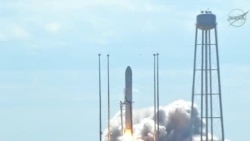WALLOPS ISLAND, VIRGINIA —
An unmanned Antares rocket blasted off from a seaside launch pad in Virginia on Wednesday, sending a new cargo capsule to the International Space Station.
The 13-story rocket, developed by Orbital Sciences Corp. , lifted off at 10:58 a.m. EDT (1458 GMT) from the state-owned Mid-Atlantic Regional Spaceport on Wallops Island.
The two-stage booster, making its second flight, soared southeast over the Atlantic Ocean, leaving behind a pillar of smoke and flame visible from New York City to South Carolina as it headed into orbit.
Perched on top of the rocket was Orbital Sciences' new Cygnus freighter, one of two robotic spaceships developed in partnership with NASA to fly cargo to the space station following the space shuttles' retirement.
The capsule was expected to reach the space station, a $100 billion research complex that flies about 250 miles (about 400 km) above Earth, on Sunday.
Privately owned Space Exploration Technologies, which began work about 18 months before Orbital Sciences, so far has made three trips to the station, a project of 15 nations.
NASA invested a total of $686 million in Orbital Sciences and SpaceX and awarded the firms contracts totaling $3.5 billion to fly cargo to the station.
“The Orbital investment far exceeds the NASA investment,” Orbital Sciences executive vice president Frank Culbertson told reporters at a prelaunch news conference on Tuesday.
Culbertson declined to be more specific about how much the company has spent to develop Antares and Cygnus.
“We're hoping for a long series of cargo resupply missions to recoup some of that [investment],” Culbertson added.
Orbital Sciences expects to quickly transition from this week's trial run to the space station into its first operational mission for NASA in December.
A successful flight may not only boost its chances for additional NASA work, but could attract commercial and scientific customers for both Antares and Cygnus.
“We have a lot interest from people who are waiting to make sure we do, in fact, succeed with this before they place a firm order,” Culbertson said.
Cygnus capsules are not designed to return to Earth, but since they can stay in orbit for extended periods of time, Orbital Sciences envisions secondary missions after the capsules depart the station, as well as dedicated flights for customers beyond NASA.
Antares, a two-stage, medium-lift rocket, made a successful debut test flight in April.
For Wednesday's flight, Antares is expected to place a Cygnus capsule, loaded with about 1,543 pounds (700 kg) of food, clothing and other supplies, into orbit.
Over the next four days, the capsule will demonstrate its ability to maneuver in space and communicate with the station.
If all goes as planned, Cygnus would fly itself to the station on Sunday so astronauts can use a robotic crane to pluck the capsule from orbit and attach it to a berthing port.
The capsule is expected to remain docked at the station until Oct. 22. About two days later, it would fire braking rockets to leave orbit and fall back into Earth's atmosphere, burning up in the process.
The 13-story rocket, developed by Orbital Sciences Corp. , lifted off at 10:58 a.m. EDT (1458 GMT) from the state-owned Mid-Atlantic Regional Spaceport on Wallops Island.
The two-stage booster, making its second flight, soared southeast over the Atlantic Ocean, leaving behind a pillar of smoke and flame visible from New York City to South Carolina as it headed into orbit.
Perched on top of the rocket was Orbital Sciences' new Cygnus freighter, one of two robotic spaceships developed in partnership with NASA to fly cargo to the space station following the space shuttles' retirement.
The capsule was expected to reach the space station, a $100 billion research complex that flies about 250 miles (about 400 km) above Earth, on Sunday.
Privately owned Space Exploration Technologies, which began work about 18 months before Orbital Sciences, so far has made three trips to the station, a project of 15 nations.
NASA invested a total of $686 million in Orbital Sciences and SpaceX and awarded the firms contracts totaling $3.5 billion to fly cargo to the station.
“The Orbital investment far exceeds the NASA investment,” Orbital Sciences executive vice president Frank Culbertson told reporters at a prelaunch news conference on Tuesday.
Culbertson declined to be more specific about how much the company has spent to develop Antares and Cygnus.
“We're hoping for a long series of cargo resupply missions to recoup some of that [investment],” Culbertson added.
Orbital Sciences expects to quickly transition from this week's trial run to the space station into its first operational mission for NASA in December.
A successful flight may not only boost its chances for additional NASA work, but could attract commercial and scientific customers for both Antares and Cygnus.
“We have a lot interest from people who are waiting to make sure we do, in fact, succeed with this before they place a firm order,” Culbertson said.
Cygnus capsules are not designed to return to Earth, but since they can stay in orbit for extended periods of time, Orbital Sciences envisions secondary missions after the capsules depart the station, as well as dedicated flights for customers beyond NASA.
Antares, a two-stage, medium-lift rocket, made a successful debut test flight in April.
For Wednesday's flight, Antares is expected to place a Cygnus capsule, loaded with about 1,543 pounds (700 kg) of food, clothing and other supplies, into orbit.
Over the next four days, the capsule will demonstrate its ability to maneuver in space and communicate with the station.
If all goes as planned, Cygnus would fly itself to the station on Sunday so astronauts can use a robotic crane to pluck the capsule from orbit and attach it to a berthing port.
The capsule is expected to remain docked at the station until Oct. 22. About two days later, it would fire braking rockets to leave orbit and fall back into Earth's atmosphere, burning up in the process.












